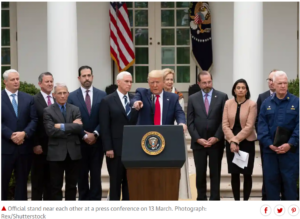COVID-19-krisen er en game-changer for de eksisterende EU’s energi- og klimapolitikker. Det vil kræve en intelligent tilpasning af de originale EU Green Deal-planer. Denne artikel fra The Centre on Regulation in Europe (CERRE) indeholder fem kritiske udfordringer genereret af den nuværende krise og forslag til at tackle disse.
Når vi lærer af denne tornede krise, bør dette hjælpe EU til bedre at forudse og styre klimaforandringer, dette århundredes ultimative udfordring. Derudover ville det være uacceptabelt at bruge påskud af COVID-19-krisen til at svække de eksisterende søjler i EU’s energi- og klimapolitik.
COVID-19-krisen påvirker vores samfund enormt og grundlæggende i vores økonomiske og sociale systemer. Det ændrer den måde, vi arbejder og interagerer på.
Da et stort flertal af de europæiske regeringer desperat forsøger at flade kurven for nye COVID-19-sager, er der ingen tvivl om, at de politiske og økonomiske konsekvenser af pandemien simpelthen er uforudsigelige:
1. The EU ETS: the first victim
The EU Emissions Trading System (ETS) is certainly the most exposed climate policy instrument to the COVID-19 shock. The carbon price is sinking, reaching its lowest levels (16 euros per tonne) since November 2018. While the CO2 price will hardly recover in 2020, the uncertainty and instability of the system may undermine the plans to phase-out coal. It may also reduce public income from auctioning revenues and may slow down low-carbon investments.
It is therefore fundamental that a new proposal to stabilise the carbon pricing system be at the top of the European Commission’s post-COVID-19 agenda. It should consider price corridors or, at least, carbon floors that will ensure coherence across the bloc for the entire phase four of the ETS (2021-2030).
The proposal for a Carbon Adjustment Mechanism should be put on hold until the ETS regains the necessary stability. Other instruments for a better and complementary carbon leakage protection of electro-intensive industries (i.e. carbon contracts for difference) should be further explored.
2. 2030 Climate Plans: no COVID-19 scenario
The second most exposed element is the plan to achieve either 40% or more than 50% GHG emissions reduction targets compared to 1990 levels by 2030. The European Commission’s Climate Plan aims at defining mandatory trajectories over the next three decades (2030-2040-2050). There is, however, an urgent need for including in the modelling exercise the implications of a global sanitary-economic crisis of the magnitude of COVID-19.
The European Commission must define new scenarios that include lower industrial outputs, crises in strategic sectors (i.e. aviation, automobile, tourism, etc.), lower carbon prices and other fundamental, socio-demographic developments which would result from a potential 5-year long recession. The recent Climate Action Plan inception assessment is a perfect opportunity to consider recession scenarios and their societal implications.
3. EEAGs: the need for flexibility
The revised Guidelines on State aid for environmental protection and energy (2014-2020), expected before the end of 2021, will have to be carefully calibrated. It should become a vital flexibility tool to soften the effect of COVID-19 in strategic sectors of the EU economy and, in particular, the operational capabilities of the entire energy industry in times of economic turbulence.
The European Commission has just launched a draft proposal for a State aid Temporary Framework to support the economy[1]. The future lessons learnt from this very valid “crisis-framework” should be integrated in the new guidelines. This will help to ensure that the entire energy system, as a strategic sector, will not be hampered in the wake of the crisis and that affordable supplies to all consumers post-crisis can be secured as long as the economy is not re-established.
The guidelines should be driven by the technology-neutral principle and be consistent with the future 2030 trajectory of the European Climate Law.
4. Distributional Effects on the rise
The fourth element is the increasingly important part that distributional effects of climate policies will play in the COVID-19 aftermaths.
The Eurozone will most definitely struggle to minimise the extent of the planned recession and unemployment rates will increase across the bloc. The implementation of new regulatory frameworks driven by stringent GHG emissions reduction targets will potentially create unexpected impacts across the different segments of the society.
The European Commission will now be integrating the distributional effects in selected impact assessments of future legislations (i.e. Energy Taxation revision). This is important but the Commission should also urgently set up an EU Observatory for Distributional Effects of the Energy Transition (ODET). It should not only allow to systematically identify best practices across the continent, but also promote new research on the distributional effects of the Clean Energy Package as well as the implementation of all the elements of the EU Green Deal.
Above all, the ODET initiative would provide public authorities and regulators with appropriate instruments to identify and then regularly update a list of “European sensitivity areas for distributional effects”. This screening exercise of specific geographical zones should include different types of socio-demographic groups based on specific income situations.[2]
5. A greater role for regulatory authorities
Finally, national (and, when appropriate, regional) regulatory authorities should acquire a greater role in the governance of the European National Climate and Energy Plans. The COVID-19 crisis represents a dramatic challenge for citizens that are deprived of regular income due to the lockdown effects.
With growing population and urbanisation, growing threats of climate change and natural disasters, growing globalisation and population movements, growing geopolitical tensions and conflicts, the capabilities and fast reaction of regulatory authorities should provide a significant contribution to the improvement of vulnerable consumers’ conditions in times of crisis and, as such, to the smooth functioning of the energy system for the benefit of all consumers.
It will, therefore, be important to systematically take into account the role that can be played, in the short and long-run, by regulatory authorities in the definition and implementation of the National Energy and Climate Plans (NECPs).
Far from being exhaustive, these five recommendations are central to challenge business-as-usual approaches among decision makers, civil society, corporate players and regulatory authorities. European policy makers in the Council, the Commission and the Parliament have a special responsibility vis-à-vis our citizens, strongly hit by COVID-19 crisis, to rethink robust models for a sustainable growth which will be driven by a solid but adapted EU Green Deal.



